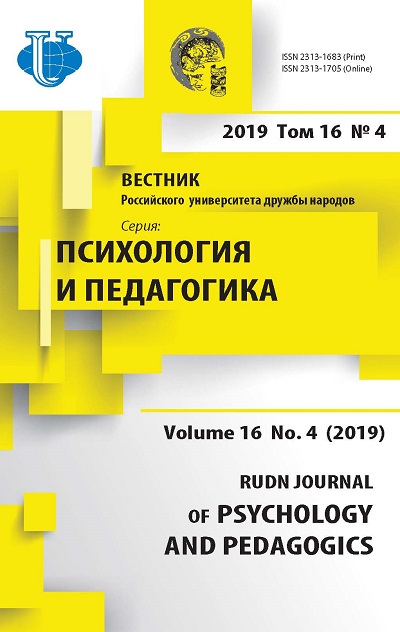The E-Course Multimodal Content, Its Specific Structure and Teaching Affordances
- Authors: Galchuk L.M.1
-
Affiliations:
- Novosibirsk State University of Economics and Management
- Issue: Vol 16, No 4 (2019)
- Pages: 634-650
- Section: PSYCHOLOGICAL AND PEDAGOGICAL PROBLEMS OF EDUCATION
- URL: https://journals.rudn.ru/psychology-pedagogics/article/view/22813
- DOI: https://doi.org/10.22363/2313-1683-2019-16-4-634-650
Cite item
Full Text
Abstract
The article presents the results obtained through the study of the multimodal segment within the Moodle-based training course in terms of its specific features and affordances for creating an innovative system of vocationally oriented foreign language teaching in nonlinguistic Master’s degree programmes. There is a need to research the functionality of the e-course semiotically different constituents when they co-occur and specify their contribution to the efficient presentation and perception of the learning content in digitally supported language classroom, which makes the research relevant. It envisaged identifying a set of multimodal resources and elements within the e-course, examining the image - text relations in terms of logico-semantics, specifying the teaching properties and affordances of such multicode combinations and assessing their learning effect through the students’ grade report as well as their feedback on the satisfaction with the multimedia learning content. The obtained results confirm that the e-course multimodal resources and elements derive their synergistic effect in terms of meaning and function from the complex interaction of the different modes constituting them. The digital nature of the multimodal learning content provides it with a set of specific properties such as multimedia, interactivity, nonlinear information flow, informativeness and gamification that when apply in teaching may contribute to creating effective online vocationally oriented foreign language learning environments. The specification of text - image combination patterns in formal and semantic terms and teaching affordances of their non-verbal constituents in online language classroom adds novelty to this paper.
About the authors
Larisa M. Galchuk
Novosibirsk State University of Economics and Management
Author for correspondence.
Email: galaris_nsk@mail.ru
PhD in Philology, Associate Professor, is Associate Professor of the Department of Foreign Languages
56 Kamenskaya St., Novosibirsk, 630099, Russian FederationReferences
- Anisimova, E.E. (2003). Lingvistika Teksta i Mezhkul’turnaya Kommunikatsiya (na materiale kreolizovannykh tekstov). Moscow: Akademiya Publ. (In Russ.)
- Evdokimova, M.G. (2017). Innovative System of the Profession-Oriented Foreign Language Teaching in Nonlinguistic Universities. Moscow: Biblio-Globus Publ. 436 p. (In Russ.)
- Gavrilova, M.V. (2016). Sotsial’naya semiotika: Teoreticheskie osnovaniya i printsipy analiza mul’timodal’nykh tekstov. Political Science, (3), 101–117. (In Russ.)
- Halliday, M.A.K. (1994). An Introduction to Functional Grammar. 2nd ed. London: Arnold.
- Kibrik, A.A. (2010). Mul’timodal’naya lingvistika. In Yu.I. Aleksandrov & V.D. Solov’ev (Eds.), Kognitivnye Issledovaniya: Sbornik Nauchnykh Trudov (vol. 4, pp. 134–152). Moscow: The Institute of Psychology RAS Publ. (In Russ.)
- Kostomarov, V.G. (2010). Displeinyi tekst kak forma setevogo obshcheniya. Russian Language Journal, 60, 141–147. (In Russ.)
- Kress, G. (2010). Multimodality: A Social Semiotic Approach to Contemporary Communication. Abingdon, New York: Routledge.
- Kress, G., & Bezemer, J. (2009). Gains and Losses: Changes in Representation, Knowledge and Pedagogy in Learning Resources: Full Research Report ESRC End of Award Report, RES-062-23-0224. Swindon: ESRC.
- Kress, G., Jewitt, C., Ogborn, J., & Tsatsarelis, C. (2014). Multimodal Teaching and Learning: The Rhetorics of the Science Classroom. London, UK: Bloomsbury.
- Kress, G., & van Leeuwen, T. (1996). Reading Images: The Grammar of Visual Design. London: Routledge. 312 p.
- Lemke, J.L. (2002). Travels in Hypermodality. Visual Communication, 1(3), 299–325.
- Martinec, R., & Salway, A.A. (2010). System for image – text relations in new (and old) media. Visual Communication, (5), 339–374.
- Nazarenko, A.L. (2013). Information and Communication Technologies in Foreign Language Teaching: Distance Learning. Moscow: Moscow University Press. (In Russ.)
- Omelyanenko, V.A., & Remchukova, E.N. (2018). Polikodovye teksty v aspekte teorii mul’timodal’nosti. Kommunikativnye Issledovaniya, 3(17), 66–78. (In Russ.)
- Polat, E.S., Bukharkina, M.Yu., Moiseeva, M.V., & Petrov, A.E. (2009). Novye Pedagogicheskie Tekhnologii v Sisteme Obrazovaniya. Moscow: Akademiya Publ. (In Russ.)
- Slyshkin, G.G., & Efremova, M.A. (2004). Kinotekst (opyt lingvokul’turologicheskogo analiza). Moscow: Vodolei Publishers. (In Russ.)
- Sonin, A.G. (2003). Obshchepsikhologicheskie i kognitivnye mekhanizmy ponimaniya mul’timediinykh tekstov. Journal of Psycholinguistics, (1), 43–56. (In Russ.)
- Sorokin, Yu.A., & Tarasov, E.F. (1990). Kreolizovannye teksty i ikh kommunikativnaya funktsiya. In R.G. Kotov (Ed.), Optimizatsiya rechevogo vozdeistviya (pp. 180–186). Moscow: Nauka Publ. (In Russ.)
- Titova, S.V. (2017). Digital Technologies in Language Classroom: Theory and Practice. Moscow: Editus Publ. (In Russ.)
- Vashunina, I.V. (2007). Vzaimodeistvie Vizual’nykh i Verbal’nykh Sostavlyayushchikh pri Vospriyatii Kreolizovannogo Teksta. Nizhny Novgorod: NGPu Publ. (In Russ.)
- Vinnikova, T.A. (2009). Osobennosti strukturnoi organizatsii kinoteksta (na materiale khudozhestvennogo fil’ma “The Queen”). Tomsk State University Journal, (325), 5–17. (In Russ.)
- Voroshilova, M.B. (2013). Politicheskii Kreolizovannyi Tekst: Klyuchi k Prochteniyu. Ekaterinburg: USPU Publ. (In Russ.)
- Zakharchuk, E.A. (2016). Intermedial’nost’ kak realiya sovremennogo informatsionnogo prostranstva. Teoriya Yazyka i Mezhkul’turnaya Kommunikatsiya, 2(21), 33–38. (In Russ.)
















